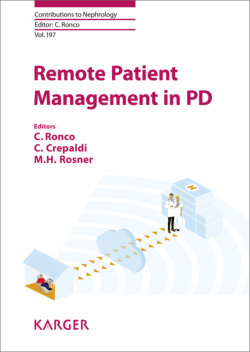Читать книгу Remote Patient Management in Peritoneal Dialysis - Группа авторов - Страница 22
На сайте Литреса книга снята с продажи.
Introduction
ОглавлениеThe utilization of automated peritoneal dialysis (APD) increased progressively from its original application, reaching 45% of the cases in 2008 in developed countries [1]. In Italy in 2016, it has been reported in 50% of patients treated by PD [2]. This represents a consequence of continuous evolution of PD cyclers. Since the first description by Boen et al. [3, 4] in the early 1960s, PD cyclers have undergone significant improvements making APD a fast-growing modality for renal replacement therapy (Fig. 1). The success of APD derives from multiple factors. Automation has permitted to overcome some of the limitations of continuous ambulatory PD (CAPD), and has led to optimized management of ultrafiltration (UF) failure, achievement of adequate dialytic clearances in anuric patients, and avoidance of poor patient compliance. Moreover, APD is the preferred modality in young patients and in those with an active life, since it allows to be free from dialysis during the daytime. On top of these factors, technological improvement of cyclers was undoubtedly the most determinant element in the growth of APD. The ability of modern cyclers to deliver accurate and reliable treatments made APD a real alternative to CAPD. In the decade between 1970 and 1980, specific improvements were carried out in the hardware, moving from manual techniques to semi-automatic cyclers. Subsequently, automatic cyclers were designed for hospital use, capable of preparing the dialysis solution from tap water and liquid concentrates. More recently, in the 1990s, continuous progresses in the hardware component led to the availability of portable cyclers, suitable for home treatment. Further evolution regarded the user interface and software design. In particular, the use of memory magnetic cards made it possible to effectively control prescription, delivery and monitoring of different APD modalities. Furthermore, patient’s card allowed to record treatments at home and review the adherence of patients when they were brought to the hospital for periodic consultation. Nowadays modern cyclers allow bidirectional communication between hospital and patient’s home, through a cloud-based platform. This real-time monitoring represents an important component of telemedicine in the field of PD and allows for a true remote patient management (RPM) in out-of-hospital treated populations where medical surveillance remains essential.
